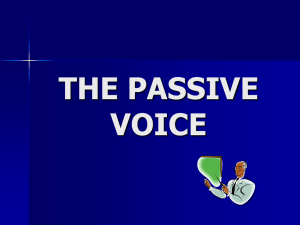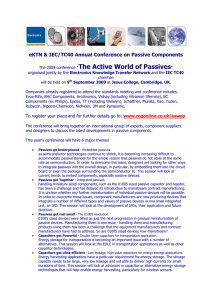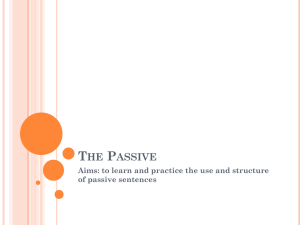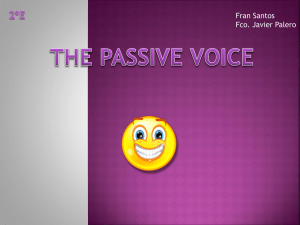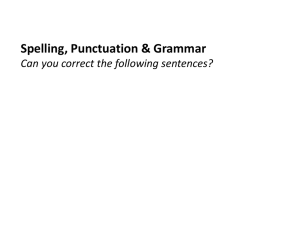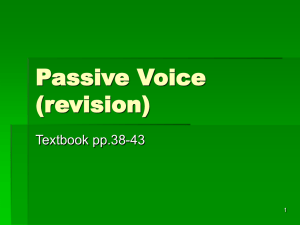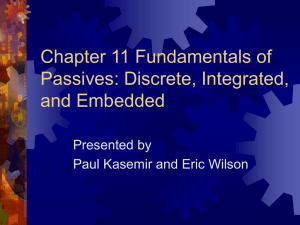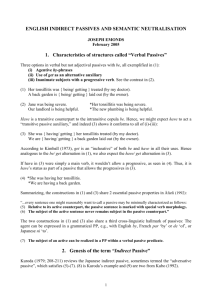Slide 1
advertisement
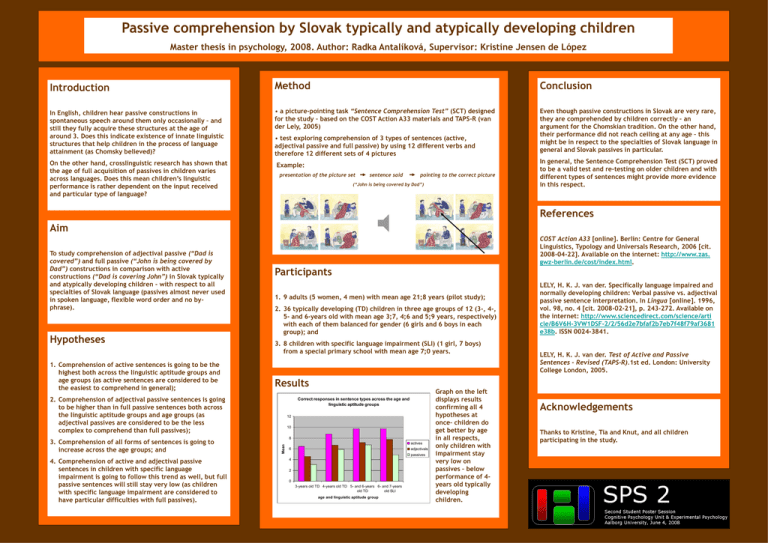
Passive comprehension by Slovak typically and atypically developing children Master thesis in psychology, 2008. Author: Radka Antalíková, Supervisor: Kristine Jensen de López Introduction Method Conclusion In English, children hear passive constructions in spontaneous speech around them only occasionally – and still they fully acquire these structures at the age of around 3. Does this indicate existence of innate linguistic structures that help children in the process of language attainment (as Chomsky believed)? • a picture-pointing task “Sentence Comprehension Test” (SCT) designed for the study – based on the COST Action A33 materials and TAPS-R (van der Lely, 2005) Even though passive constructions in Slovak are very rare, they are comprehended by children correctly – an argument for the Chomskian tradition. On the other hand, their performance did not reach ceiling at any age – this might be in respect to the specialties of Slovak language in general and Slovak passives in particular. On the other hand, crosslinguistic research has shown that the age of full acquisition of passives in children varies across languages. Does this mean children’s linguistic performance is rather dependent on the input received and particular type of language? Example: • test exploring comprehension of 3 types of sentences (active, adjectival passive and full passive) by using 12 different verbs and therefore 12 different sets of 4 pictures presentation of the picture set sentence said pointing to the correct picture (“John is being covered by Dad”) In general, the Sentence Comprehension Test (SCT) proved to be a valid test and re-testing on older children and with different types of sentences might provide more evidence in this respect. References Aim To study comprehension of adjectival passive (“Dad is covered”) and full passive (“John is being covered by Dad”) constructions in comparison with active constructions (“Dad is covering John”) in Slovak typically and atypically developing children – with respect to all specialties of Slovak language (passives almost never used in spoken language, flexible word order and no byphrase). Hypotheses 1. Comprehension of active sentences is going to be the highest both across the linguistic aptitude groups and age groups (as active sentences are considered to be the easiest to comprehend in general); COST Action A33 [online]. Berlin: Centre for General Linguistics, Typology and Universals Research, 2006 [cit. 2008-04-22]. Available on the internet: http://www.zas. gwz-berlin.de/cost/index.html. Participants 1. 9 adults (5 women, 4 men) with mean age 21;8 years (pilot study); 2. 36 typically developing (TD) children in three age groups of 12 (3-, 4-, 5- and 6-years old with mean age 3;7, 4;6 and 5;9 years, respectively) with each of them balanced for gender (6 girls and 6 boys in each group); and 3. 8 children with specific language impairment (SLI) (1 girl, 7 boys) from a special primary school with mean age 7;0 years. Results 2. Comprehension of adjectival passive sentences is going to be higher than in full passive sentences both across the linguistic aptitude groups and age groups (as adjectival passives are considered to be the less complex to comprehend than full passives); 4. Comprehension of active and adjectival passive sentences in children with specific language impairment is going to follow this trend as well, but full passive sentences will still stay very low (as children with specific language impairment are considered to have particular difficulties with full passives). 12 10 8 Mean 3. Comprehension of all forms of sentences is going to increase across the age groups; and Correct responses in sentence types across the age and linguistic aptitude groups actives 6 adjectivals passives 4 2 0 3-years old TD 4-years old TD 5- and 6-years 6- and 7-years old TD old SLI age and linguistic aptitude group Graph on the left displays results confirming all 4 hypotheses at once– children do get better by age in all respects, only children with impairment stay very low on passives – below performance of 4years old typically developing children. LELY, H. K. J. van der. Specifically language impaired and normally developing children: Verbal passive vs. adjectival passive sentence interpretation. In Lingua [online]. 1996, vol. 98, no. 4 [cit. 2008-02-21], p. 243-272. Available on the internet: http://www.sciencedirect.com/science/arti cle/B6V6H-3VW1DSF-2/2/56d2e7bfaf2b7eb7f48f79af3681 e38b. ISSN 0024-3841. LELY, H. K. J. van der. Test of Active and Passive Sentences - Revised (TAPS-R).1st ed. London: University College London, 2005. Acknowledgements Thanks to Kristine, Tia and Knut, and all children participating in the study.
